One of the most accurate indicators out there is telling us a recession is ahead. And—odd as it sounds—that warning is bringing us a chance to buy a 6.9%-paying fund with two key advantages:
- This fund—a closed-end fund (CEF), to be precise, generates extra income when the bull takes a breather, making its 6.9% payout even safer, and …
- It’s cheap, in relative terms, and will likely be in higher demand as a recession nears.
That fund, the Nuveen NASDAQ 100 Dynamic Overwrite Fund (QQQX) is at the center of our strategy today because of something that sounds obscure but should be on every investor’s radar: the yield spread between 3-month and 10-year Treasury notes is negative—meaning the yield on the 3-month is higher than that of the 10-year.
This only happens ahead of a recession. In fact, over the last half-century, this “inverted yield curve” has predicted every recession, with zero false positives. (Though the lag is often long, so the actual recession could still be a ways off.)
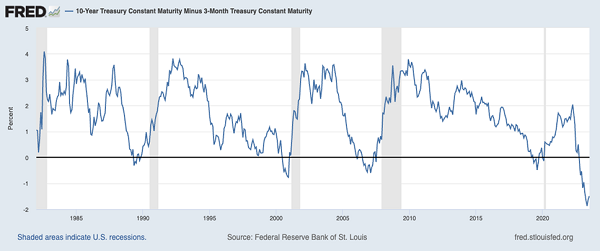
The upside here is that the coming recession means interest rates will be cut in the longer term. Which, after the string of swift Federal Reserve hikes we’ve endured, is understandable. When those cuts come, they’ll set the economy (and stocks) up for another round of growth.
For now, though, at least another hike or two is ahead, making debt more expensive and stunting the loan growth that fuels the housing market, auto purchases and consumer spending as a whole.
And with the striking down of the Biden Administration’s student-loan forgiveness plan, the CARES Act–induced pause on repayments that began in 2020 will come to an end in October. As a result, 42.4 million borrowers owing roughly $1.7 trillion will begin paying those loans back.
With interest and principal, that’s roughly $400 per month less in discretionary income for each of those borrowers. That’s about two-thirds of Americans between 18 and 35.
What This Means for Income Investors
When recession warnings appear, you can either sell and go to cash, short-sell stocks or—our preferred option—add assets that bolster your portfolio with strong income streams and other hedges that offset market declines.
Selling and going to cash is out—doing so leaves us vulnerable to inflation. Plus we’ll slash our income stream! And the last thing we want is to reduce our income from high-yield assets such as CEFs just as a recession hits.
Short selling? Even worse. With short selling, your potential for losses is infinite (as stocks can theoretically rise to any level, while they can only go to zero with regular buys). Moreover—and few people think of this when short selling—short sellers are on the hook for the dividends the stocks they “borrow” pay out. It’s the exact opposite of smart income investing.
Just imagine being “short” the NASDAQ 100 in 2023, with a return of nearly 40% in just half a year, as of this writing. It proves that markets are very forward-looking. And therein lies the best news we have as income investors: the coming recession is already priced in, and we’re nicely set up to buy into the market, especially through our favorite high-yield CEFs.
Priced-In Recession Is a Great Buying Opportunity
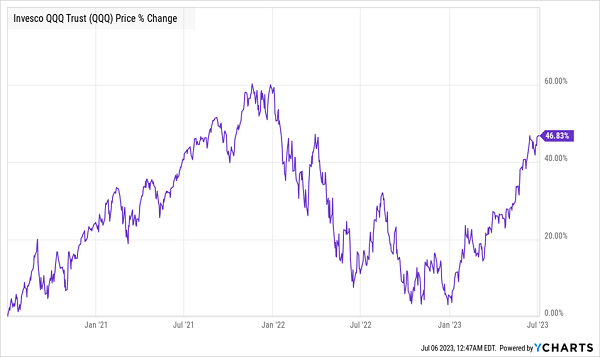
As of now, the market is pricing in the recession we can see from the inverted yield curve, and investors are realizing they priced in a recession a bit too much late last year.
When this happens, you can easily buy stocks—and better still, equity-focused CEFs—knowing that a recession is coming because you know what the market is expecting. And while we’ve been talking about this for months at Contrarian Outlook, now you might feel like it’s too late and buying into a recession bull market, as paradoxical as that seems, would be a mistake.
If you do feel that way, you’re not alone. A lot of people are beginning to step to the sidelines. Hence the sharp jump in stocks we saw in January and again in May (after banking-crisis worries eased) has begun to level off, as we can see in the performance of the NASDAQ benchmark Invesco QQQ Trust (QQQ) ETF below:
Stocks Start to Cool
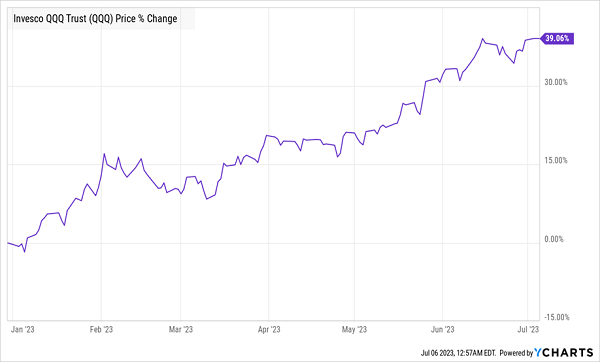
When this happens, the likeliest event over the short term is flatness. It’s a situation that reminds me a lot of 2016, when a worried public thought stocks would pull back, resulting in a price downturn that lasted a short time, with the S&P 500 recovering quickly, only for the gains up to July to flatten out by the end of the year.
A Similar Market to Today

This is where QQQX comes in because it does something many professional investors do in a flat market: it sells call options against its holdings—the stocks in the NASDAQ 100 index in this case—to help fuel its impressive 6.9% dividend. That, in effect, gives us an income stream that’s built to hold up, regardless of whether stocks rise or fall. And we can keep collecting that income stream without selling a thing, as long as stocks stay flat.
Now, one look at QQQX’s performance chart reveals that the fund has, in fact, underperformed the market in 2023.
Market Lag Sets the Stage for Future Upside
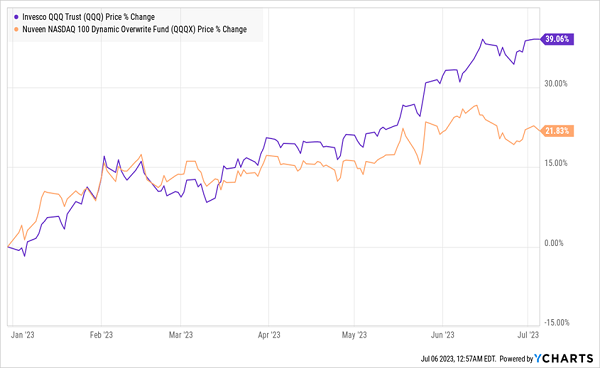
But remember that this fund intentionally caps its profits by selling call options at predetermined strike prices, which is not a good strategy in a bull market. But it’s a great one in a flat market.
Finally, we have an attractive entry point, with QQQX trading at a 2.5% premium to net asset value (NAV). Normally we avoid CEFs trading at premiums, but we’ll make an exception for QQQX because discounts are rare on this tech-focused CEF. Moreover, that premium is down from the north-of-8% levels we saw in March (and the double-digit premiums of late 2022):
QQQX’s Attractive Valuation
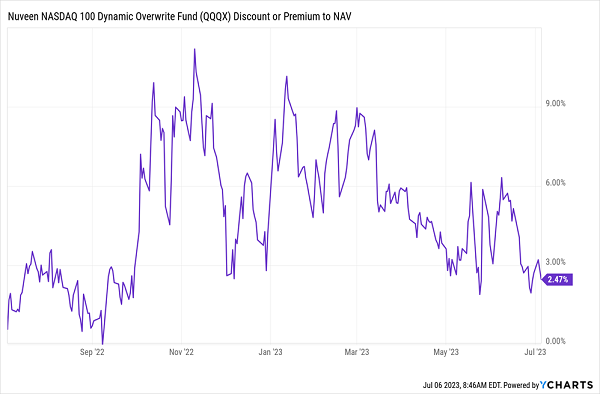
Put it all together and we have a fund that gives us upside potential and a high, well-supported yield that helps hedge our downside. That’s a good setup for the flat market we’re likely to see in the coming months. It also makes QQQX a favorable option for a pullback, should one materialize.
These 5 Huge CEF Dividends (Yielding 9%+) Are Recession-Proof …
… and “Powell-proof” too!
No matter what happens with the Fed or the economy, these 5 stout income plays will keep pouring out their rich 9%+ payouts. That’s much more than you can get from stocks, Treasuries, CDs, you name it. And best of all, these 5 CEFs pay dividends monthly, too.
These 5 CEFs are also cheap now, setting us up for strong upside ahead. Simply click here and I’ll share my full CEF-investing strategy and give you the opportunity to download a Special Report naming all 5 of these monthly paying—and 9%+ yielding—CEFs.
